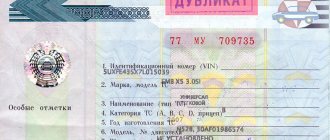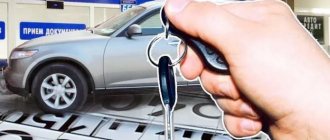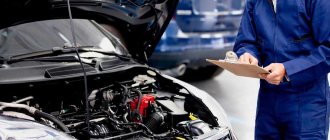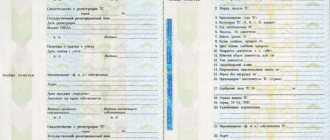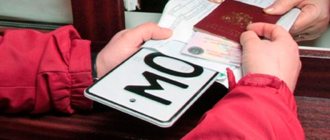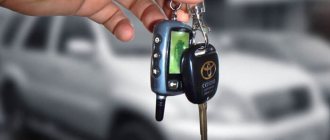Procedure
We recommend that you carry out the first check of the car at the stage of viewing advertisements. Choose the options you like, write down the license plates and check the cars using the Autocode service. The system will issue a report with a detailed history of the car. If the information in the ad contradicts the report data, it is better to immediately abandon this option and not waste time meeting with the seller. Most often, sellers hide the real mileage, number of owners, work in a taxi and participation in an accident.
Start the meeting by checking your documents. Next, proceed to a visual inspection of the car. After that, take it for a test drive. Finally, go with the seller to the service station. Specialists will identify all the technical flaws of the machine. This will allow you to bargain or even refuse to buy a bad vehicle.
Documentation check
Before buying a used car, it is important to check the documentation:
- PTS;
- vehicle registration certificate;
- seller's passport.
Make sure that there are no special stickers or marks on the PTS. What's the catch here? Marks are placed in cases where the body or engine numbers are interrupted, unreadable or unreadable.
Be wary if the seller provides you with a duplicate title. A duplicate PTS is issued if the original was lost or damaged, and also if there are no free lines left to enter the owners of the car. Therefore, you need to check with the seller how many owners the car had and for what reason the duplicate was made.
Also read: What the PTS will tell you: how buyers of used cars are deceived
But don’t rush to refuse to buy a car just because it’s a duplicate. Check your car using the Autocode service. If the verification data does not contradict the seller’s words, then there is nothing to fear. If the service reports that the vehicle had two or more owners, and the seller claims that he is the first and last owner, then it is better to refuse the transaction.
Be sure to check the data from the seller’s passport with the data specified in the PTS. Even small differences in documents may subsequently lead to you not being able to register the car.
Checking your car for fines
There is always a possibility of purchasing a car with outstanding fines. Often, sellers themselves do not know about the debts to the traffic police, but sometimes they deliberately withhold information so that all debts fall on the new owner.
Of course, if you buy such a car, you cannot be forced to pay these fines; this is the responsibility of the former owner. However, there are situations when, due to non-payment of fines, registration restrictions are imposed on the car. In this case, the new owner will not be able to register the car.
To identify the presence of fines, you can use the following services:
- official website of the traffic police;
- Autocode service.
To check a vehicle through the official website of the traffic police, you need to know both the license plate number of the car and the number of the registration certificate. To check using the Autocode service, you just need to know the license plate number of the car. At the same time, from the report, in addition to the history of fines, you will learn data on mileage, technical inspections, compulsory motor liability insurance, restrictions and much other important information.
Checking the car for collateral
If a car owner takes out a loan secured by a vehicle or a car loan, then the car is collateral. If you do not know this information when purchasing, then the bank or mortgage holder may subsequently oblige you to repay the loan or collect the collateral from you.
You should not immediately refuse to buy if the car is pledged to the bank. Sometimes credit institutions themselves put up for auction and sell interesting models at a fairly low price.
How to check whether a car is considered collateral? To do this, you can use the following sites:
- register of the notary chamber;
- Autocode service.
To check a car through the registry of the notary chamber, you need to know information about the pledgor, the registration number of the notice and the VIN of the vehicle. For Autocode, a VIN or license plate number is sufficient.
For professional car sellers, we have developed a service for unlimited car checks “Autocode Profi”. “Autocode Pro” allows you to quickly check a large number of cars, add comments to reports, create your own lists of liquid vehicles, quickly compare options and store data about cars in an orderly form. A subscription to unlimited car checks costs 2,500 rubles per month.
What happens if you don't check the documents before buying a car?
When buying a car, you may find out that the car is stolen. In this case, after lengthy legal proceedings, the car you purchased has the right to be transferred to the true owner.
If the purchased car is on credit or pledged, then at any time the pledge holder can come to the buyer and pick up the vehicle. Therefore, it is very important to check the car before purchasing. The Autocode service shows the deposit, theft, traffic police restrictions, accidents and other data. Information is collected from more than 13 sources, and a full report with verification is generated in just 5 minutes. The cost of one report is 349 rubles. Therefore, it is advisable to use Autocode if one or more checks are needed.
If you need to constantly check a large number of cars, use the “Autocode Pro” unlimited car check service. A subscription to unlimited car checks costs 2,500 rubles per month. “Autocode Pro” allows you to add comments to reports, create your own lists of liquid vehicles, quickly compare options and store data about cars in an orderly manner.
Often resellers do not include themselves in the title as another owner. This means that when selling a car, they only act as an intermediary between the buyer and the last owner under the title. In case of any legal problems that arise after purchasing a car, you will have to look for the former owner. The outbid is not listed in the documents, which means there will be no liability for the car.
To avoid various kinds of legal problems, even at the stage of technical inspection of the car, you need to carefully check all the documents.
Mileage check
More than 50% of car sellers inflate mileage. This procedure costs from 1,000 to 3,000 thousand, while the owner increases the cost of the car when selling it by a larger amount.
Also read: How sellers cheat mileage
You can check the veracity of mileage data in several ways:
- check documents;
- carry out a proper inspection of the vehicle;
- contact specialists.
Also read: How to check car mileage
Determine your actual mileage
Alexander Dolgikh , automobile blogger, journalist:
— Odometer readings are the last thing you should trust. Try to determine the mileage based on the condition of the interior.
Count. A private car covers 10-20 thousand kilometers a year. Five years – 100 thousand.
Check. By the end of 100 thousand kilometers, the brake discs will have a maximum edge of 2-3 mm. If you see that the wheels are new, it means that the car has run for more than a hundred.
Study. If the pedal pads are worn down to metal or, conversely, completely new, the car’s mileage has exceeded 300 thousand kilometers.
Inspect. By 5 years of use or 150-200 thousand kilometers, scuffs appear on the steering wheel. You can determine how and where the car was used. You see the “9 o’clock” position - the owner often traveled long distances, “9” and “15 o’clock” - around the city. If there are abrasions all over the rim, the owner probably tampered with it.
Explore. The driver's seat upholstery made of fabric begins to deteriorate after 100-120 thousand kilometers, leather - after 190-200 thousand. The armrest and lateral support on the left are severely worn out if the car is left-hand drive. In the case of a right-hand drive car, it’s the opposite.
Also read: How to check car mileage
Check for participation in traffic accidents
More than 75% of cars have been in an accident at least once, and sellers often try to hide this fact.
We talk about the signs of a damaged car and how to check for participation in an accident in a separate article.
If during inspection of the car you notice signs of repair, check the car using Autocode. From the report you will find out where, when and what type of accident the car was involved in.
Checking for restrictions
Beware of car purchases that are subject to restrictions. We have prepared a special material in which we talk about restrictions on cars and what they can mean for the new owner.
In what cases are restrictions imposed:
- if the customs authorities have suspicions that the vehicle was cleared through customs under a “gray” scheme;
- if the vehicle is the subject of a dispute in court;
- if the owner of the car is obliged by court to pay a bailiff a certain amount of money.
Also read: What are the risks of buying a car that is seized?
You can check your car for restrictions on the official website of the traffic police. To do this, you need to know the VIN code or chassis number.
The check can also be carried out through the official website of the bailiffs. To do this, you need to know the owner’s passport details, SNILS or TIN.
Users of the Autocode service can learn about restrictions
, imposed on the vehicle, according to the license plate number.
Checking against the traffic police database
Basic information about the vehicle is contained in the traffic police database. Here you can check whether it has been stolen, the history of registration actions, and restrictions. You can obtain information yourself on the official website of the traffic police by entering the VIN code.
The disadvantage of this verification method is the need to obtain a VIN and frequent failures when sending a request.
You can check your vehicle against the traffic police database at any traffic police department. But this requires the presence of the owner. The check is carried out only upon presentation of documents for the car.
Checking a car for theft
If you purchase a used car that is listed as stolen, there is a chance that you will have to sue the owner who has turned up. In 85% of such situations, the judge obliges the new owner to return the vehicle to its real owner. In this case, you will lose not only the car, but also the money spent on it. It is unlikely that you will be able to get your money back from a fraudster who hid the fact of the theft during the transaction.
Also read: How stolen cars are sold and how to check for wanted cars
To check, you can use the following methods:
- check through the official website of the traffic police;
- together with the seller, deregister the car (if the car is stolen, the seller will not be able to carry out this action).
You can also use Autocode and get a more detailed report about the car in just 5 minutes.
How to check a car through the traffic police website?
In order to independently check the legal purity of a car before buying it in person, go to the official website of the State Traffic Inspectorate in the services section and select the item “Vehicle check”. The link to direct access to this service is https://www.gibdd.ru/check/auto/. After this, you must enter the full vehicle identification number in a special field. When the VIN is indicated, you can start checking the car yourself; to do this, in each field you need to click on the “request verification” link and enter the code suggested by the system. What will we see in the traffic police service?
Checking the registration history of a car in the traffic police
For the first check point - “History of vehicle registration in the traffic police”, we will have access to the make and model of the car, year of manufacture, chassis, color, engine displacement, power and type of vehicle. The most important! we will see periods of ownership of the vehicle and persons - physical or legal. In fact, only the first criterion for independently checking a car when purchasing it second-hand will give us complete information about the technical side of the car and the number of owners.
The next stage is “Checking whether the car was involved in an accident.” If the vehicle has not been involved in an accident, the system will report that, as a result of checking the traffic police database, no records of accidents with this vehicle have been identified. If the car was involved in an accident, the circumstances of the accident and their number will be indicated.
Related links: Payment of traffic police fines without delay in 2017
Next, the car can be checked to see if it is wanted. Simply put, this means that the car is stolen. After the criminals steal the car, its rightful owner will write a corresponding statement to the police. From this moment on, the car in the traffic police system receives the status “Wanted”. This means that no legally significant actions can be taken with it. If you buy a car that is wanted, you simply will not be able to register it with the State Traffic Inspectorate.
Availability of vehicle restrictions
Finally, the last way to check for a vehicle is to check whether the vehicle has any restrictions. The most common way to restrict a car is a ban on registration actions. This means that the current owner of the vehicle is evading paying traffic fines. In this regard, the bailiff, who is searching for the debtor, imposed a registration ban on his vehicle. Due to this restriction, it will not be possible to remove the car from the traffic police register. First, pay off the debt and only then sell the car! As you can see, checking a car yourself allows you to find out a lot of details, so we strongly recommend using this service when buying a car second-hand! A timely refusal to complete a transaction on a car that does not have complete legal clearance will save your nerves, time and money.
Testing for work in a taxi
"Autocode" provides its users with the opportunity to check whether the vehicle is registered with official taxi services.
If a service check gives you such information, then it is better to refuse the purchase. Such a machine, even if it is relatively young, has most likely practically exhausted its service life. That is, you will face constant repairs that require large financial investments.
Also read: A car after a taxi: how to recognize it and whether it’s worth buying
Checking a car for recycling
These days, a new fraud scheme has emerged among unscrupulous car owners. They deregister the vehicle, dispose of it, and try to sell the vehicle as soon as possible at a fairly low price. As a rule, buyers are attracted by cheapness. But needless to say, it will not be possible for you to register such a vehicle. Money will be thrown away.
Also read: How to check a car for scrap, what are the risks of buying a scrap car
Whether the car was scrapped or not can be found out from the Autocode report.
To do this, just enter the license plate number of the car.
In addition, you can contact the traffic police with a statement. However, this will require the personal presence of the car owner. Or you can use the official website of the traffic police. In this case, you need to know the VIN.
Technical check
Technical verification is no less important than legal verification. During it, you will be able to visually identify all the shortcomings and defects of the vehicle. We will tell you how to properly check.
When checking a car, you need to pay attention to the following aspects:
- tire wear;
- presence of corrosion;
- paintwork;
- replacement of body parts;
- repairs on the slipway;
- motor operation.
Also read: How to check a car using a thickness gauge
Also read: How to check whether a car has been in an accident
To entrust the technical inspection to a specialist, use the on-site inspection service. An expert will be on site at the right time and will examine the car using special instruments.
Determine if the car is damaged
Alexander Gudov, owner and manager of the IskraRS :
There are 10 clear signs of participation in an accident and distortion of the body geometry:
- The color of the paintwork under the seals differs from the shade on the body;
- There is no paint on the hood bolts, door hinges, gas tank flap;
- The gaps on the body parts are not symmetrical;
- The markings and year of manufacture of the glasses differ;
- The hood, trunk, and doors close with force;
- The moldings were splattered with body-color paint;
- Body stampings and lines do not fit together;
- The windshield is cracked with no visible center;
- The headlights are different, one is cloudy;
- There are no small scratches, dents or chips on the front bumper.
Also read: How to check whether a car is damaged or not
Monitor tire wear. If you see that the tires are worn unevenly, the body may be crooked. Check at a car repair shop - mechanics will help you figure it out using special devices and stands.
Test Drive
A test drive is an integral part of checking the technical condition of a car. If the seller of a used car insists that he does not have time to drive around the city, then it is better to refuse the purchase. Most likely, serious shortcomings that appear while driving are being hidden from you.
Before the test drive, ask the seller what investments will be needed after purchase. Most often, under the guise of minor flaws, quite large problems are hidden that will require a lot of money. Carefully remember all the faults that the seller mentions. They will have to pay more attention during the test drive.
Also read: How to Test Drive a Used Car
While driving, go at both low and higher speeds. Check for any unusual noises or knocks. For example, if the steering wheel vibrates when driving, this may subsequently lead to replacing the box. And such a procedure costs at least 30,000 rubles.
Take a test drive
Alexander Morozov, auto expert, radio host:
— The car has passed a visual inspection - proceed to the test drive. It is important to evaluate:
- operation of the braking system, suspension;
- starting and idling the engine;
- the presence of suspicious noises and knocks in the suspension, engine;
- steering wheel position, car controllability;
- operation of electric windows, radio, instrument panel, air conditioner, heater;
- presence of jerks when changing gears.
The seller may not let you drive, but you don’t need that. Get in the car together, ask him to accelerate, slow down, turn, turn around and drive over speed bumps or other bumps in the road. Such a test drive will show the technical condition of the suspension and brakes. Observe the owner's actions carefully from the front passenger seat. If he turns the steering wheel and uses the gearbox without effort, the car is fine.
Also read: How to test drive a car
